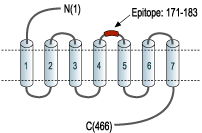Overview
- Peptide EDETI(S)QINEEPG(C), corresponding to amino acid residues 171-183 of human α1A-adrenoceptor (Accession P35348). Extracellular, 2nd loop.

 Cell surface detection of Alpha-1A adrenergic receptor by direct flow cytometry in live intact mouse J774 macrophage cell line:___ Cells.
Cell surface detection of Alpha-1A adrenergic receptor by direct flow cytometry in live intact mouse J774 macrophage cell line:___ Cells.
___ Cells + Rabbit IgG Isotype Control-FITC (#RIC-001-F).
___ Cells + Anti-α1A-Adrenergic Receptor (extracellular)-FITC Antibody (#AAR-015-F), (5µg). Cell surface detection of Alpha-1A adrenergic receptor by direct flow cytometry in live intact human THP-1 monocytic leukemia cell line:___ Cells.
Cell surface detection of Alpha-1A adrenergic receptor by direct flow cytometry in live intact human THP-1 monocytic leukemia cell line:___ Cells.
___ Cells + Rabbit IgG Isotype Control-FITC (#RIC-001-F).
___ Cells + Anti-α1A-Adrenergic Receptor (extracellular)-FITC Antibody (#AAR-015-F), (5µg).
- IUPHAR RECEPTOR DATABASE | ADRENOCEPTORS.
- Piascik, M.T. and Perez, D.M. (2001) J. Pharmacol. Exp. Ther. 298, 403.
- Perez, D.M. et al. (1993) Mol Pharmacol 44, 784.
- Minneman, K.P. (1988) Pharmacol. Rev. 40, 87.
Adrenergic receptors (also called adrenoceptors) are the receptors for the catecholamines adrenaline and noradrenaline (called epinephrine and norepinephrine in the United States). Adrenaline and noradrenaline play important roles in the control of blood pressure, myocardial contractile rate and force, airway reactivity, and a variety of metabolic and central nervous system functions.
Adrenergic receptors are members of the G-protein coupled receptor (GPCR) superfamily of membrane proteins. They share a common structure of seven putative transmembrane domains, an extracellular amino terminus, and a cytoplasmic carboxyl terminus.
Adrenoceptors are divided into three types: α1, α2 and β adrenoceptors. Each type is further divided into at least three subtypes: α1A, α1B, α1D, α2A, α2B, α2C, β1, β2, β3.1,2 They are expressed in nearly all peripheral tissues and in the central nervous system.1,2
All α1-adrenoceptors (α1-ARs) activate phospholipases C and A2.3 In addition to mobilizing intracellular calcium, the α1-ARs have also been shown to activate calcium influx via voltage-dependent and -independent calcium channels.4
The α1A-ARs have at least nine known alternative spliced isoforms. They are the most abundant adrenergic receptor in the brain, and are considered postsynaptic receptors. α1A-ARs are also expressed in the heart, liver and prostate.
Application key:
Species reactivity key:
Anti-α1A-Adrenergic Receptor (extracellular) Antibody (#AAR-015) is a highly specific antibody directed against an extracellular epitope of human α1A-adrenergic receptor. The antibody can be used in western blot, immunohistochemistry and flow cytometry applications. It has been designed to recognize α1A-adrenergic receptor from human, rat, and mouse samples.
Anti-α1A-Adrenergic Receptor (extracellular)-FITC Antibody (#AAR-015-F) is directly conjugated to fluorescein isothiocyanate (FITC) fluorophore. This conjugated antibody has been developed to be used in immunofluorescent applications such as direct flow cytometry and live cell imaging.
